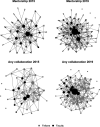Building the Next Generation of Researchers: Mentored Training in Dissemination and Implementation Science
- PMID: 32941251
- PMCID: PMC7769184
- DOI: 10.1097/ACM.0000000000003750
Building the Next Generation of Researchers: Mentored Training in Dissemination and Implementation Science
Abstract
Problem: Dissemination and implementation (D&I) science provides the tools needed to close the gap between known intervention strategies and their effective application. The authors report on the Mentored Training for Dissemination and Implementation Research in Cancer (MT-DIRC) program-a D&I training program for postdoctoral or early-career cancer prevention and control scholars.
Approach: MT-DIRC was a 2-year training institute in which fellows attended 2 annual Summer Institutes and other conferences and received didactic, group, and individual instruction; individualized mentoring; and other supports (e.g., pilot funding). A quasi-experimental design compared changes in 3 areas: mentoring, skills, and network composition. To evaluate mentoring and D&I skills, data from fellows on their mentors' mentoring competencies, their perspectives on the importance of and satisfaction with mentoring priority areas, and their self-rated skills in D&I competency domains were collected. Network composition data were collected from faculty and fellows for 3 core social network domains: contact, mentoring, and collaboration. Paired t tests (mentoring), linear mixed models (skills), and descriptive analyses (network composition) were performed.
Outcomes: Mentors were rated as highly competent across all mentoring competencies, and each mentoring priority area showed reductions in gaps between satisfaction and importance between the 6 and 18 months post-first Summer Institute. Fellows' self-rated skills in D&I competencies improved significantly in all domains over time (range: 42.5%-52.9% increase from baseline to 18 months post-first Summer Institute). Mentorship and collaboration networks grew over time, with the highest number of collaboration network ties for scholarly manuscripts (n = 199) in 2018 and for research projects (n = 160) in 2019.
Next steps: Building on study findings and existing literature, mentored training of scholars is an important approach for building D&I skills and networks, and thus to better applying the vast amount of available intervention evidence to benefit cancer control.
Conflict of interest statement
Figures



References
-
- Brownson R, Colditz G, Proctor E, eds. Dissemination and Implementation Research in Health: Translating Science to Practice. 2018. 2nd ed New York, NY: Oxford University Press.
-
- Byars-Winston A, Dahlberg ML. National Academies of Sciences, Engineering, and Medicine. The Science of Effective Mentorship in STEMM. 2019. Washington, DC: National Academies Press. - PubMed
Publication types
MeSH terms
Grants and funding
LinkOut - more resources
Full Text Sources
Medical
Miscellaneous

